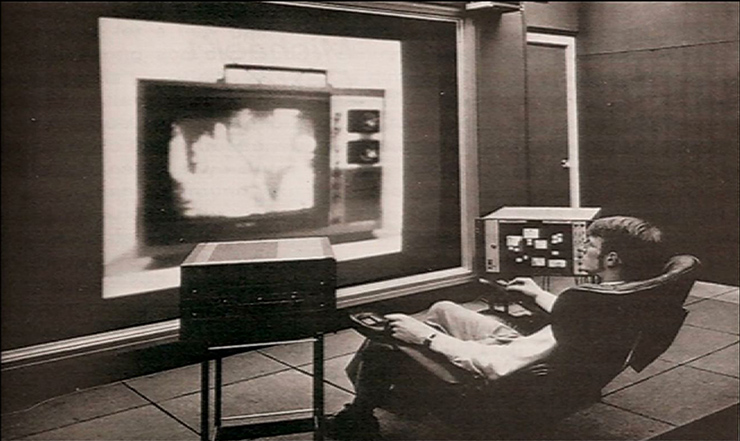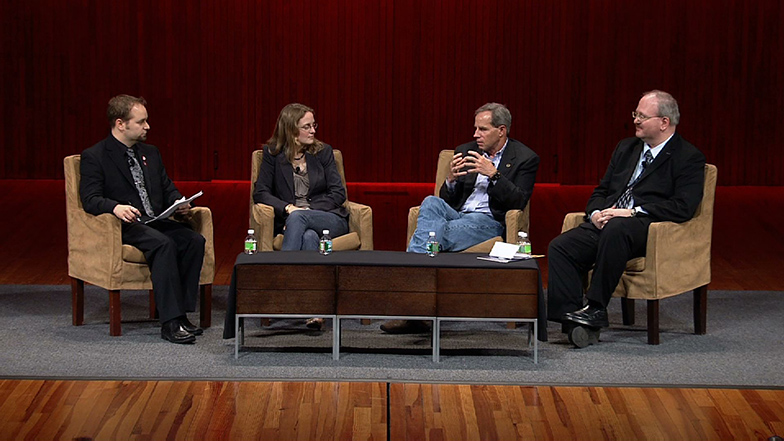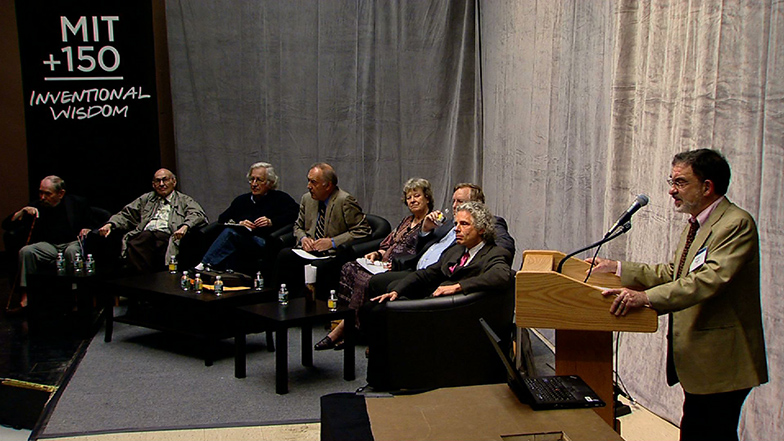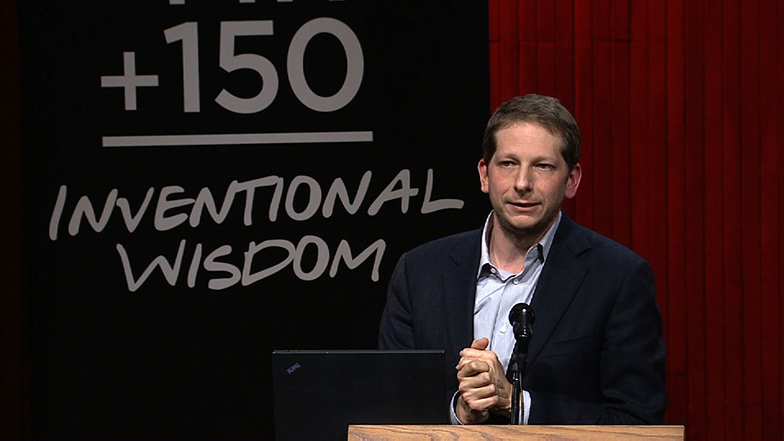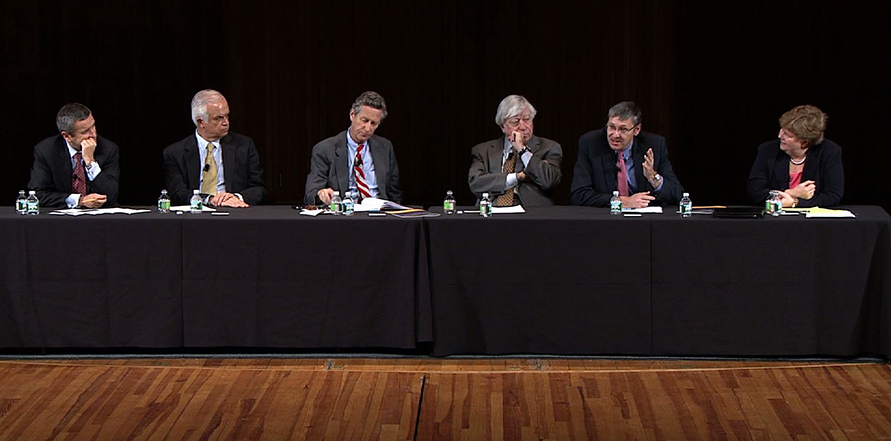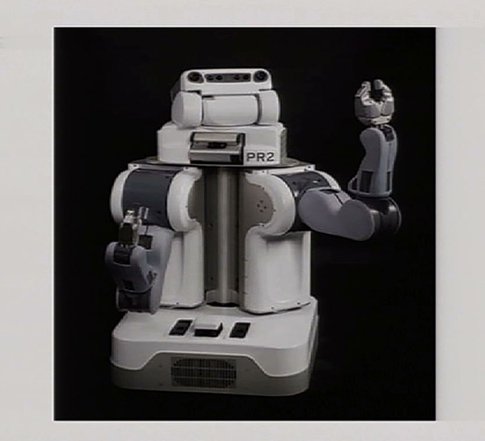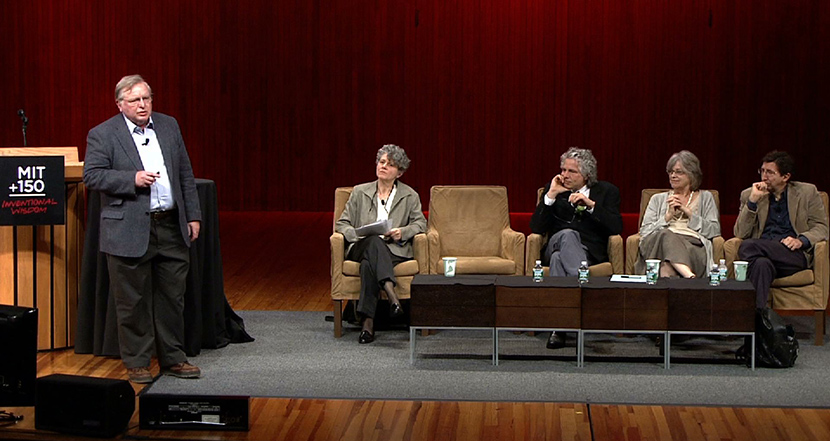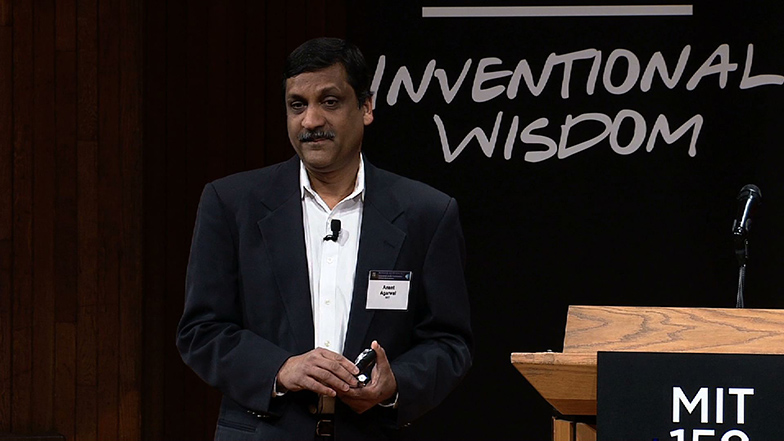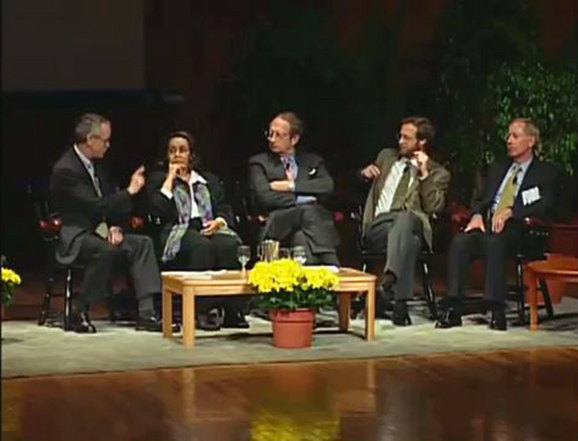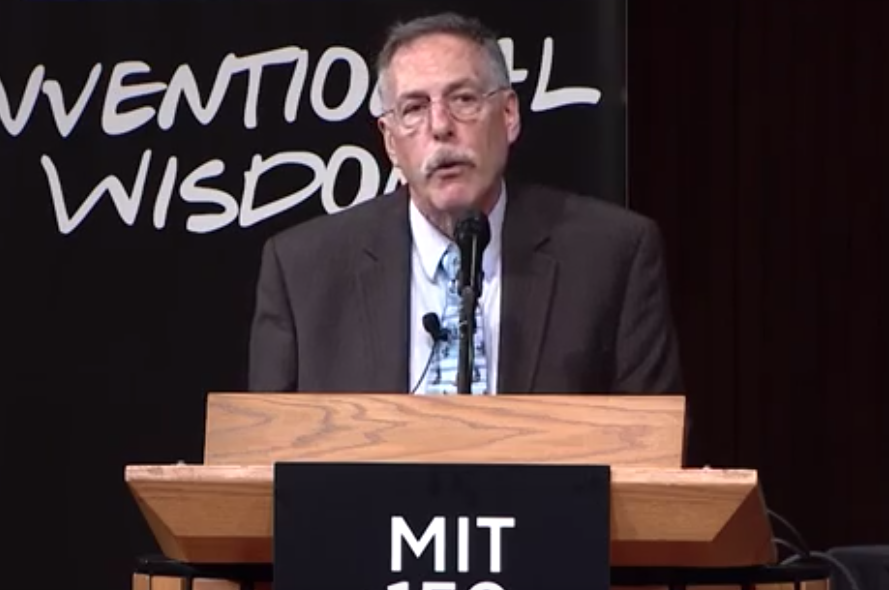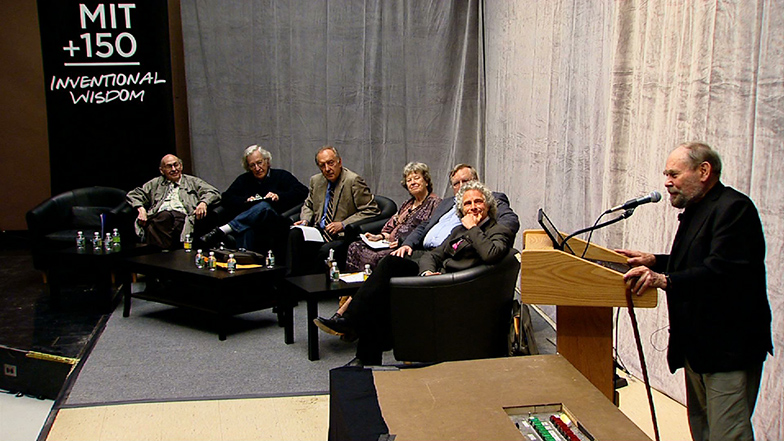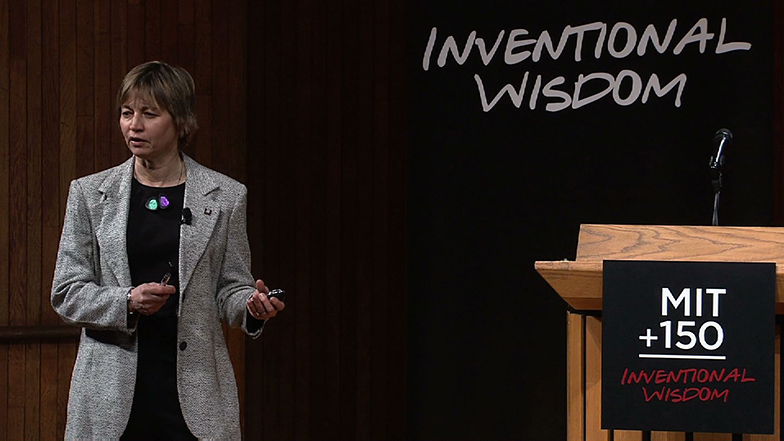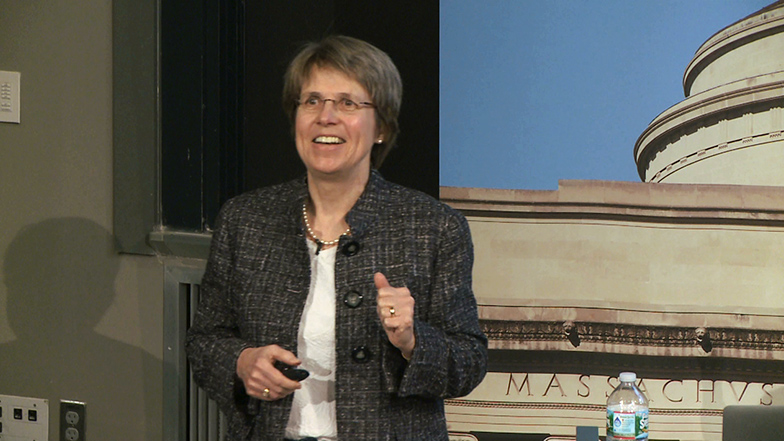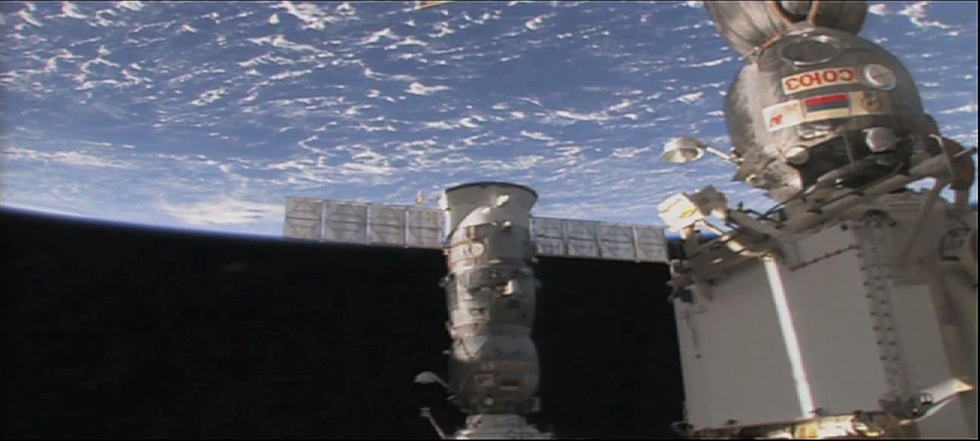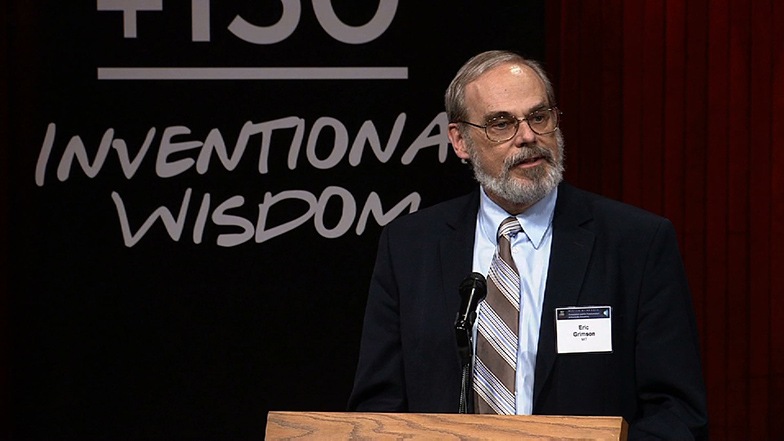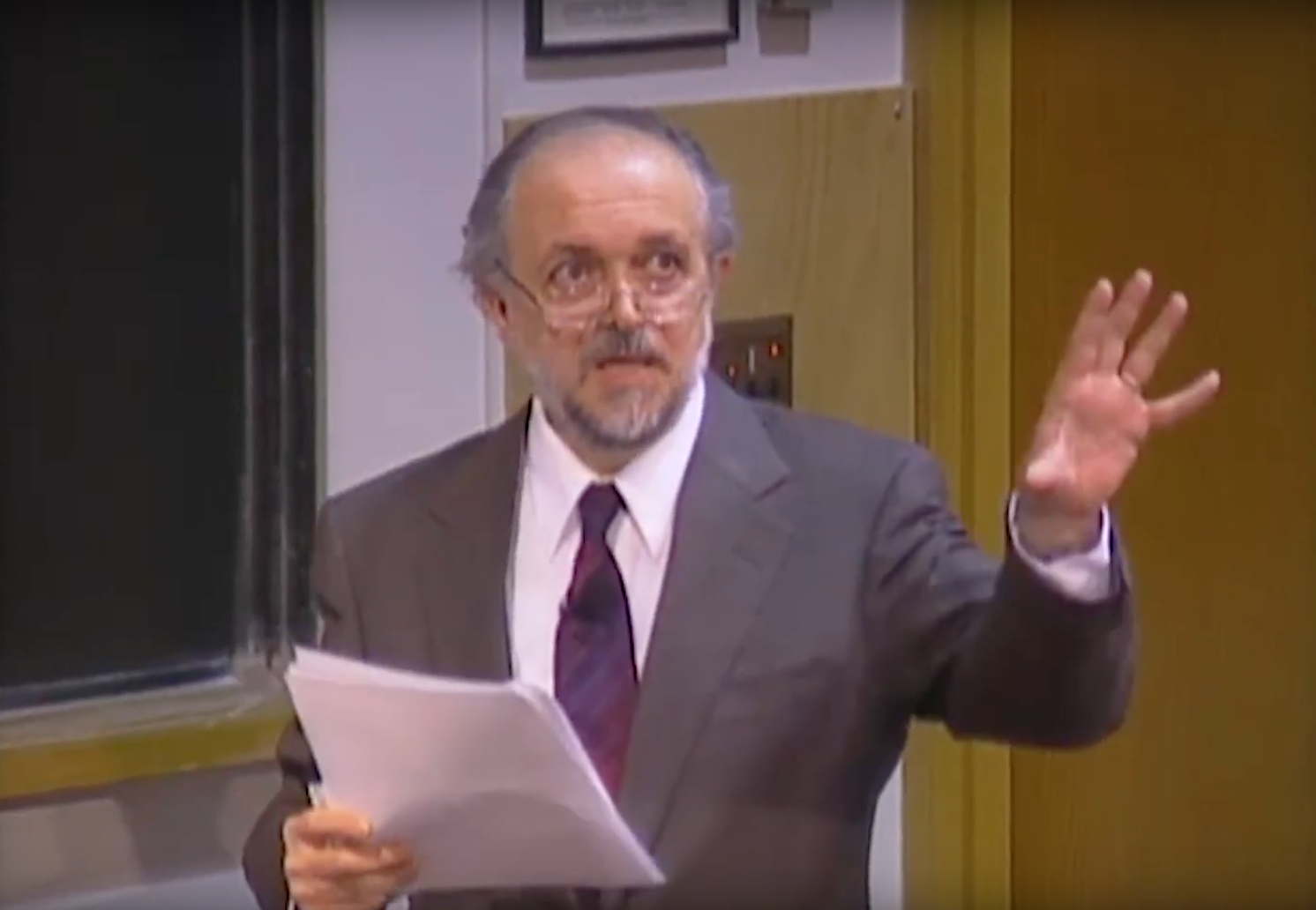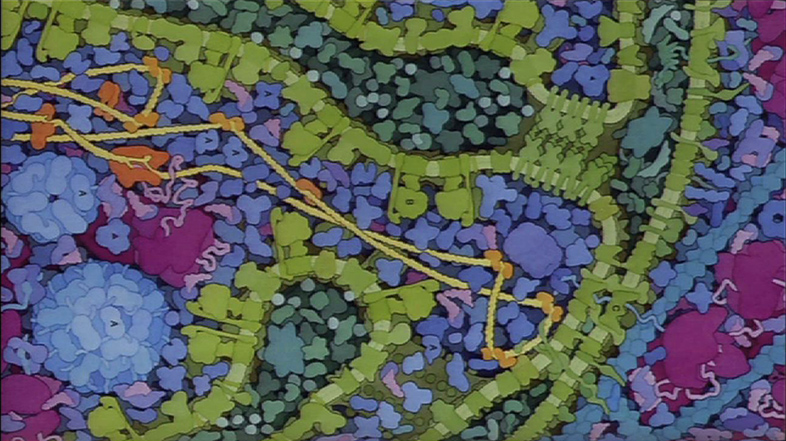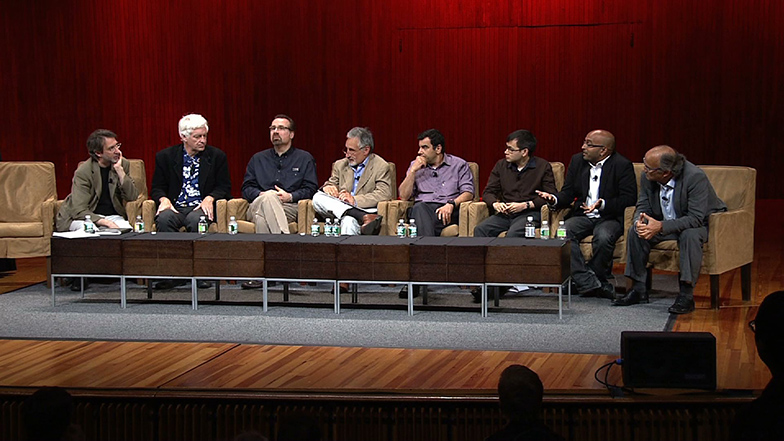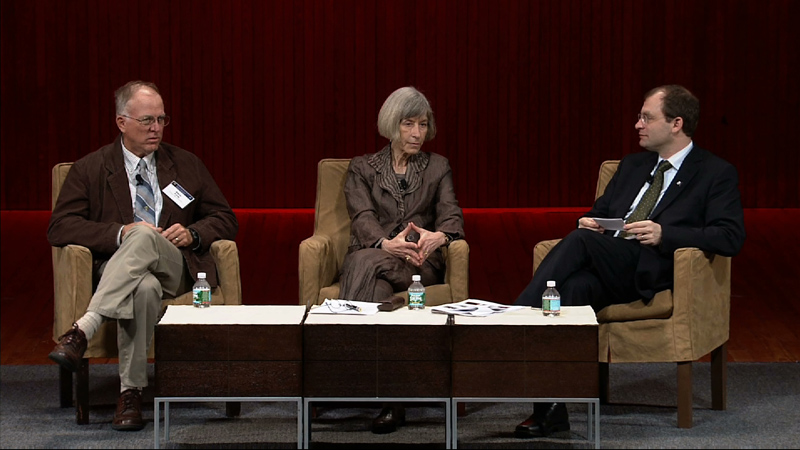Future of Exploration: Explorers Panel
ZUBER: Well I'd like to welcome all of you back this afternoon when we continue in this interesting exposition of focusing on, today, what it's like to explore. And we have a very exciting panel discussion for you here this afternoon. I'm Maria Zuber. I'm a professor of geophysics and head of the Earth Atmospheric and Planetary Sciences department here at MIT. And I will be moderating and speaking this afternoon.
Buzz Aldrin, we decided that being on a panel with many other astronauts could not possibly give him the opportunity to impart sufficient insight that he has of his career of explorations. So we're delighted that he will be talking more to us this afternoon.
We have Steve Squyres who's the Goldwin Smith professor of astronomy at Cornell University and has done a number of different things. He's a investigator on Mars Odyssey and an investigator on the imaging team of Cassini but is probably best known as principal investigator of the still going on Mars Exploration Rover Mission still going. How many days of the 90 day mission? 2,581.
[LAUGHTER]
So he has something to say about longevity, I'm sure.
And James T. Bellingham, who's the chief technologist of the autonomous ocean sampling network program of Monterey Bay Aquarium Research Institute. Okay, so we will also be having, at the end of the 10 minute presentations here, we have a video clip from Cady Coleman from the International Space Station, as well, who, obviously, could not be with us personally.
Okay, so people ask me what it's like to be an explorer. And I'll tell you. I feel so blessed to be able to do what I do for a living. And it's just I feel remarkable that I get paid to do it, in fact.
But when people say what's it like, and how do you spend your day, it's actually a little bit worrisome because, what I do, I talk on the phone, I make PowerPoint presentations, and I fly on airplanes. And that's most of my time. But I explore the solar system.
And currently, I'm on five active, robotic exploration missions, which does a great job of filling the hours of a day. And I thought I would just take a couple of minutes here and just talk about one of them and, basically, just show you some pictures. This is for a mission called GRAIL, the Gravity Recovery And Interior Laboratory Mission.
This is a dual spacecraft mission. We're going to have two spacecraft that we'll be launching to the moon. The launch window opens September 8 of this year. Many of you will be invited to the launch. If you'd like to be invited, let me know. We'll put your name on the list.
And this is MIT's first PI ship in full space mission. So I thought I'd tell you just a little bit about it. Okay, so here are the two spacecraft. And actually, in the exposition over where you had lunch today at 5 o'clock, Lockheed Martin kindly sent out some models of the two spacecraft. So you can see them.
They're not quite to scale size. But they're about the size of a dishwasher. So they're a very small spacecraft. And some people like big spacecraft. But like small spacecraft because launch cost per dollar. They're very inexpensive.
So these two spacecraft will be launching to the moon on the same launch vehicle. They will take about four months to get to the moon. They will insert into orbit around the moon on New Year's Eve and New Year's Day of this year keeping with the NASA tradition that all critical things happen on holidays so that people have to work, okay.
And there are reasons why we're actually doing that that are actually quite sensible, which I won't go into. And these two spacecraft, they're going to be in polar orbit around the moon about 50 kilometers above the surface. And they will range to each other. And we will range to them from Earth at different radio frequencies.
And by looking at small variations in the velocity between the two spacecraft, we will determine the gravity field of the moon better than we know the earth's gravity field. So here is a picture. I like hardware, so most of this presentation is hardware.
This is one of the antennae on the spacecraft. And these two spacecraft will arrange to each other and determine if the velocity of one spacecraft with respect to each other to couple of tenths of a micron per second. So what we're doing, actually, isn't very hard. It's just that we need to do it pretty well.
Okay, this is a lot of flight hardware. And actually, what I wanted to do by showing this picture is just to convey the fact that, while this spacecraft is unusual for NASA spacecraft in that it doesn't have a whole suite of instruments-- it just has one instrument per spacecraft-- but that there are a lot of components associated with doing a spacecraft mission and that every single thing here has to be done perfectly for this to work.
So if you want a range to a couple of microns per second, it's very precise. So I want to point out this reaction wheel assembly right here. And it's about this big. And this has given me more problems than you can imagine.
And if you can see this here, this is a picture of the celebration when the reaction wheels from the company were delivered to NASA. And this is Goodrich Ithaca Company in Ithaca, New York. Steve, maybe you know some of these people. But look at how they're dressed.
This was supposed to be a small modification of something that we knew how to do. And it turned out to be a real research project. And we had some outstanding technicians and engineers who had to actually engage in acts of nothing short of heroism in order for this to happen.
So when they made the delivery and these devices worked extremely well, there was a great celebration, which was well deserved. So here are some pictures of two of the spacecraft. The spacecraft are being built out at Lockheed Martin in Denver. So you can see them here full size.
Here's one of them. And here's this one in foreground, and then the other one being worked on in the background. And as I said, they're very small. If you see me bolt out of here tomorrow afternoon, it's because I'm heading out for yet another review. I have, at least, one review a week because these two spacecraft are being delivered to Cape Canaveral in May.
Okay, here are the most important thing that you do in robotics is test, test, test, test, test. And so here are just some pictures of our team testing the variety of complements on the two spacecraft, okay. Here is a picture of the instruments being loaded on a plane out in Pasadena.
And they were flown to Denver to be put on the spacecraft. And this is just a placeholder to say that when the two spacecraft get sent to Cape Canaveral that I'm going to be in the cargo plane with the spacecraft. And my managers were telling me, Maria, you don't have to do this. We can just send them out there. You can meet us in Florida.
And I said, they're my spacecraft. I'm delivering them to Cape Canaveral. And I'm landing on the shuttle landing strip. And no one else is delivering these. And I was talking to Steve Squyres at lunch time. And he said he did the same thing with the Mars Exploration rover. So you tend to feel very attached to these things.
Here's my rocket. I'm very excited to have a job where I can say I bought a rocket. And I bought this one. I got this picture and, actually, on the same day that I got this picture, I got a picture of a fuse board that melted in testing. And I decided to show you this picture because I thought it was a lot more uplifting.
But the fuse board has since been repaired. And we have no issues there but in case you get the false impression that this is simple. Here's our launch pad here. And I just want you to know I have a folder on my computer with about 40 e-mails on it concerning the design and the font of the name of the mission, okay.
It has never happened before that the name of the mission is in the same size font as the name of the rocket, okay. So it took 40 e-mails for this to happen but we persevere. I was unwilling to settle for a smaller font.
So I'm pleased to say one of things I want to talk about is outreach and how what we do is so exciting that it engages students who have talents in critical and analytical thinking, in mathematics, in science, and in technology that these are endeavors that are worth study. And so I'm always thinking about new ways that we can get students involved in exploration.
So I said if I ever won a mission, I was going to do this properly. So I immediately went to Sally Ride, America's first woman in space who devotes her career to getting students involved-- particularly, middle school girls-- keeping them interested in math and science.
And so we have four camera heads on each spacecraft that have no scientific purpose. They are on the spacecraft totally to do outreach where students at schools will be able to program images so they can take their own images of the moon.
And Sally has done something similar with something called Earth Cam on the space station. It's been incredibly successful. But I think the public deserves ownership in space. And kids are awfully smart. And it doesn't take a whole lot to get them motivated to go in and figure out how to run the software so that they can program images to take pictures of the moon.
And I just want to end here with a nice picture of the moon over Cape Cod. And imagine what it's like to be sitting on the beach and to be able to look up at the moon and to know that you have made observations where you have gained understanding of the moon that no one else knows for a short period of time.
It's just an amazing feeling. And it's something that never gets stale. And it drives me. And it motivates me. And it's a wonderful career to have. And I'll end right there. Thank you.
[APPLAUSE]
Okay, now I'm going to ask Steve Squyres to come up.
SQUYRES: Thanks, Maria. And could I have my first slide up? Any time you get invited to participate in an event where the words the future of appear in the title of the event, I think it's wise to approach it with a certain amount of humility and trepidation.
In my normal work, my every day work, I'm used to, as Maria mentioned, working with instrumentation that looks something like this. In order to prepare for today's event, however, I've had to familiarize myself with a different form of instrumentation.
And so what I'm going to try to do for the next 10 minutes here is gaze into that crystal ball and give you, sort of, some thoughts on what the future of space exploration-- I'll be focusing largely but not exclusively on robotic space exploration-- might look like. Now my crystal ball for the next 10 or 20 years is maybe not too cloudy.
One of the things that I've been participating in recently is something called the Decadal Survey, which is something that NASA does every 10 years with their National Research Council to plan the next decade or to a planetary exploration. So the first couple things that I'll be talking about actually come from that the Decadal Survey and are plausibly actually going to happen.
The First of them that I want to mention is the very challenging task of returning rocks from the surface of Mars. We have learned so much about Mars with the spacecraft that we have sent there in the last 10 or 15 years. But we've reached the point where the next big increment in understanding is going to come from bringing rocks back from the surface.
Now to do that, you got to do a bunch of things. And the plan is to actually break it up into three missions. The first mission shown in the upper left is a Rover-- a bit bigger than Spirit and Opportunity-- it would drive around and collect a cache of rocks, and take those rocks, and put them in a container on the martian surface.
The second mission, shown at the right, lands near that cache, picks it up, puts it into the nose cone of a small rocket, and launches into orbit around Mars. A spacecraft the size of a coconut that contains those samples. The third mission shown at lower left goes to Mars, goes into orbit, finds that coconut in space, puts it into a sample return canister, and sends it back to Earth.
This is an incredibly challenging suite of missions. But what it will do is it will return a set of samples that can continue to provide good science about Mars for decades into the future. Another one that all of us in the planetary science community are extremely excited about is Europa.
Europa is one of the moons of Jupiter. It's roughly the size of the earth's moon. But it has a crust of ice on the outside. And there is good reason to believe that beneath that crust of ice lies an ocean of liquid water.
So we got two, possibly, accessible oceans in the solar system. One here on earth, the other one on Europa. And one of the missions that we're looking at is a mission that would go and orbit Europa with a number of instruments, including a long wavelength radar that can see through that ice, tell us how deep it is to get to the water, tell us where the thin spots are, tell us where the places where you might go and land.
And the thing that's exciting about Europa is that, of course, with that ocean being present, it's conceivable that down on that sea floor there could be hydrothermal vents, there could be the kind of local environments that support life at the bottom of the earth's oceans.
Another exciting place is Titan. Titan is a moon of Saturn. It's a huge thing. It's like the size of the planet Mercury. It has a dense atmosphere of nitrogen. The atmospheric pressure at the surface of Titan is higher than it is in this room.
And it has an active hydrological cycle where it rains, and there are rivers, and there are lakes, except it's not water. It's liquid methane and liquid ethane at the temperatures of 80 or 90 degrees above absolute zero. So it's a fantastic world. And it's the kind of place that you can use rather familiar forms of transport to explore.
You can fly a balloon in the atmosphere of Titan. You can sail a boat in the methane ethane lakes on the surface. You could do submarines down at the bottom of those lakes. So Titan is going to be a fantastic place to explore, as well.
Now once you look further out into the future, that's where my crystal ball grows a little more cloudy. But let me tell you about some of the things I'd like to see happen. I talked earlier about Europa, and the idea that there is an ocean of liquid water, and that we can find where the thin spots are.
Well the obvious thing to do next is to go into that ocean. This is a phenomenally difficult mission. And this is going to happen decades in the future. You have to land. Then, somehow, you have to get through-- I'm going to wave my arms and guess-- about 10 kilometers, maybe, of ice. Maybe you melt your way through it.
And then, when you get down into that water column, you've got 100 kilometers of water between you and the sea floor, which is where the interesting science is. So you need some kind of autonomous, underwater vehicle that can swim down to the bottom of that ocean and, in the vastness of that ocean, find the interesting spots and explore them.
And then, somehow, get the data back. And all of this has to take place on a moon that is embedded deep in the Jovian magnetosphere with a hellaciously difficult charge particle, energetic particle, environment at the surface of Europa. This is a very, very, very tough mission. I hope it happens in the next 50 years.
Here's another one, Enceladus. Enceladus is a fantastic place. It's, again, one of the moons of Saturn, but it's a tiny little thing. It's only 500 kilometers in diameter. And yet, despite its small size and you would expect it's very cold temperature, there are geysers. Literally, geysers of water that are erupting from the south pole of Enceladus. And we know this from the Cassini spacecraft having flown through it.
And it's not just water, okay. There's organic materials being erupted in these things. What is in those vents? What is in those fractures? A mission I'd love to see you can see at the upper left there.
This is the kind of collector system that you might fly if you could fly a spacecraft through the plumes from one of those geysers and then, again, return samples to earth and figure out what's going on inside of Enceladus. Now I talked so far, mostly, about robotic exploration. Obviously, there's a great future for human exploration, as well.
And when you look at it realistically, the three kinds of objects you can see humans going to in the foreseeable future are the moon, asteroids, and Mars. Let me express my personal view on this. And that is that I believe it makes sense to send humans to the places where humans because of their unique capabilities, contribute the most.
And humans contribute most, in my view, in complex environments. The more complicated, the more difficult, the more unpredictable the environment, the more humans add to the mix. And when you look at those three classes of objects-- the moon, asteroids, and Mars-- the one that stands out in terms of its complexity and in terms of its potential for humans to contribute the most is unquestionably Mars.
Mars is far more complex than the moon. Mars is far more complex than asteroids. Mars is the place where humans make the most difference. And so, in my view, the future of human exploration should be focused towards getting to Mars.
Now that doesn't mean that you can't make sensible stopping points along the way. There may be places where you have engineering milestones or development milestones like the moon to show your capabilities before you go onto Mars. But to me, for humans, Mars is clearly the target.
Okay, so now looking way downstream. I'm going to look 150 years into the future now, and maybe more than that. To me, the real frontier is planets around other stars. This spacecraft here is Kepler. This is a spacecraft that is observing a patch of sky in the constellation Cygnus.
Here's the piece of sky that it's looking at. Just a little part of the sky. And what it's doing is it's detecting planets around other stars by looking at the tiny dips in the light curves from these stars when the planet passes in front of the star.
The spacecraft's been up there a little while. They've been staring at stars for a while trying to find planets. And here are the planet candidates just in that tiny patch of the sky. There are lots, and lots, and lots of worlds out there to explore.
And the blue ones among these candidates, those are earth sized. So I think the most exciting thing that we have in the future of exploration is to study these worlds. Initially, it will be from our solar system looking out with ever more advanced telescopes.
But the thing that I look forward to in the very distant future is actually sending spacecraft to planets around other stars. It's going to happen. It will first happen robotically. You can think of a number of technical challenges that are associated with doing something like that.
Certainly, communications is going to be a challenge. Certainly, autonomy of your spacecraft and we're talking about spacecraft that are light years away. Having those spacecraft operate completely autonomously in very poorly understood environments will be key. But the toughest problem, the singular problem that must be solved before we can ever think about traveling to other stars, is propulsion. I heard [INAUDIBLE] mentioned earlier in the discussion before lunch I think that's, quite possibly, going to be the way to go.
And for all you smart, young students at MIT, if you want to make your mark on the future, one thing to think about is how to develop a propulsion system that's going to get us to other stars because that's the thing that excites me most. Thank you.
[APPLAUSE]
ZUBER: Okay, we'll next hear from Buzz Aldrin.
[APPLAUSE]
ALDRIN: Thank you for such a long introduction.
[LAUGHTER]
Whoever is controlling the slides, could you go to the one that show-- oh. I don't know. I point this at you guys out there? All right. I talked about this a little bit earlier.
This is what I call a comparison between the direct landing on the moon and what we actually did. The rocket that Wernher Von Braun wanted was the Nova rocket, nine engines. And on top of that, they'd have a propulsion system and this sizable spacecraft.
The Nova rocket wouldn't be ready in time. So he could split this up between this spacecraft and the TLI stage, trans-lunar injection. The upper stage of the rocket that would send this spacecraft.
And an MIT doctoral candidate who works with Ed Crowley did the size measurements of this just to put a point across that to send a multipurpose-- that is my name for this big monstrosity because a crew would be launched on it. It would go to the moon. It would do its landing, support those activities, then come back and land in the ocean.
No separate, specialized spacecraft at all. John Houbolt based his suggestion. And doggedly, he pursued it and has been my role model, so to speak, for quite a while. He said to the folks at NASA, now, if you specialize this spacecraft and have a lander kind of like this, and put it on one Saturn V along with the command and service module. You only need one Saturn V. So get that. Two Saturn V's for one spacecraft to the moon and back, multi-purpose. Specialized spacecraft, two of them, only needs one Saturn V.
That's a big deal. And I just want to point out that just don't say, well, we went to the moon with lunar-orbit rendezvous. And it was better than earth-orbit rendezvous. The big difference is multipurpose.
And that's exactly what the senate and the congress want us to build, and mandate it that we build a multipurpose from the surface of the Earth to Earth orbit. And then, from Earth orbit all the way to Mars or asteroids or whatever else, and all the way back, and it lands in the ocean.
Of course, we do specialize the lander, whether it's on Phobos or Deimos or the surface of Mars. And not actually for the moons of Mars. We could use an Orion habitat.
Let me just develop a little bit for you engineering folks out there. If we want to send a specialized spacecraft or plural, a long distance with high demands on reliability and long-term life support, we can put all of that in one big, large spacecraft. But now compare that with two medium sized.
About the same size, medium, and we avoid single point failures as much as possible but something happens and knocks out one of those medium vehicles, we still have the other one. Now let's take those two medium, and one gets smaller, and the other one gets bigger until the small one disappears. And you were back where we started from with one big one.
Now somewhere in that trade space is a more optimum. And I don't think it's to the same size. What you'd like to have at either earth or at Mars is a space, an Orion taxi, and you'd like to have an Orion hab, but not an Orion that's a government that lifts off from the surface of the earth, and goes into Earth orbit, and then does some of these others.
That's a government spacecraft. And it's not going to compete well with the civil spacecraft, especially when it's a copy of Apollo that goes all the way to the moon and back because when we go to the moon or, according to the Constellation Program, we were going to go there for, at least, six months. And that spacecraft was going to stay in orbit unmanned until the crew lifts off again, and then they come home.
So it doesn't have a crew in it. Now the Constellation Program, as I see it, originated from a desire to quickly copy what we did in Apollo. But it began to deviate from that when the accident board opened the door-- accident board of Columbia-- by saying separate crew and cargo.
Now we could have just done that and put it on some rocket. But instead, we wanted to put a small rocket. And it's my contention that ATK lied when they said a four segment solid could do the Aries 1 mission.
They had been trying to sell a five segment solid to the Air Force for quite a few years. And the Air Force just wasn't interested. So they said, oh, okay, we can get a command module or an Orion to rendezvous with the lander somewhere in earth orbit. But the Orion is going to have an upper stage on a four segment solid.
Well it wasn't long before that, obviously, wasn't going to work. And they put the five segment solid in there. And even that wasn't enough. When you look at Orion, you should ask the question why is the service module with fuel so small? Well because it doesn't have the capability of putting the lander, and the CSM, or the Orion into lunar orbit.
You got to put the fuel in the lander. And that makes the rocket even bigger. And a land is just gigantic-- not quite this big. All right, now this is kind of a quick unified space vision. Now this is what I presented to the Augustine group.
This is a modification of it. But what it really shows is the ability to, kind of, start out and 2010, '11, and proceed around the clock this way. When we first constructed this, the guy that constructed it knew that orbits go this way.
So he had the thing up here going this way. But that isn't the way a clock goes. So we rearranged it with the potential. This is the 50th anniversary of the lunar landing. And we affirm that we're on the right path. And we do various missions.
The first thing we've got to do is to develop, really, a long-term life support system. We do that at the space station. And then, we have a prototype of the Orion hab. And then, we start flying them along with the Orion taxi.
And we can do that in low earth orbit. And then, we can cycle missions back and forth between the Earth and the moon demonstrating what could be done in a private spacecraft with cycling orbits between Earth and Mars for adventure travel. We're doing that to check out the spacecraft under varying conditions over a period of time.
And then, leaving the hab module at either L1 or L2. Let me move to the next one. Maybe I have to go back this way.
All right, hopefully, you can see this. This was put together about two years ago. And I was hoping that the last five shuttle would be delayed a year between the missions so that we could-- between those year missions of the shuttle going to the station, three months before and three months after, are occupied in getting ready and checking out after the mission lands.
So you have about six months in between. And I felt that the work force could be working on the next lifting body runway lander that would start to fly along here. And this shuttle launch system would be evolved into a direct type, which, at the time I prepared this, is what I felt we probably ought to do. The quickest and the cheapest.
When it began to look like we were also going to study liquid rocket boosters, not being a real friend of solid rockets at all from the very beginning, I kind of changed my approach and wanted to retire the orbiter as soon as possible and transfer over to launch vehicles. And I think a lot of people convinced me that the cost of doing this sort of thing just wasn't going to work.
So we have a test bed at the space station. And then, the first exploration module is more of a prototype. Then, we start flying in Earth Moon cycling orbits around 2017, '18. We retire one of these in lower earth orbit for refueling and another one at L1 and L2.
There's a comet. And I think the next advance mission is a one year orbit where you are on a free return trajectory whenever the engine might cut off. And it's kind of simpler than rendezvousing with an asteroid. And there is this comet that we could fly by, at this term, [? vintanin. ?]
Then, there are two asteroids, 2001 GP2. There are many others that could be in here. And then, Apophis. I'm sure that you know Apophis is the asteroid that, at first tracking, it looked like there was a fair chance that it could impact the earth in 2029 on Friday the 13th of April.
Further refining of the orbit looks like, well, that's probably not the case. But it could also go inside a geosynchronous orbit. And the probability of distance inside geosynchronous has a key hole in it. And if it goes through that keyhole, it's going to raise it's semi major axis from being below earth's orbit, and moving in a catching up way to above Earth's orbit.
And so earth is catching up to it so that, in 2036-- Easter Sunday, April-- this would impact the earth somewhere between northern Japan and down the California coast to around Panama. And the middle of that is, maybe, 200 miles off the coast of California with 150 foot tsunamis.
Now obviously, we don't want that to happen. But we can make up a pass by Apophis in about 2021. The next thing we'd like to do is to land a habitat, an Orion hab on Phobos. And then, check that out while we're sending a human mission to occupy that.
I've selected three year and a half missions of three mission controllers or communicators with the robots that are sent to the surface of Mars in this 1 and 1/2 year period. And then, this crew would go there, come back. The second crew would go and do the same thing, come back.
And the third crew would go there with a lander and land, maybe, a week before the six people come from the earth and make nine people occupying the Mars somewhere between 2031 and 2035. Having these sequence of missions progressively getting more and more ambitious is going to keep the interest of the public.
And I think it'll result in more and more challenging opportunities. Everything in here can be [? slid-- ?] synodic periods of Mars. I'm getting the hook I see. So I'll be happy to answer questions on this and other things like travel to Alpha Centauri. The book being made into a movie is called Encounter With Tiber.
[APPLAUSE]
ZUBER: Great, thank you, Buzz. I'm sure there will be questions about this. So I want to remind people that there will be smiling people sending out index cards for your questions that we'll take. Our next speaker is Jim Bellingham.
BELLINGHAM: To whoever scheduled me to go after this vision for exploring the solar system, I'll talk to you later. I'm going to take you back to Earth. I think you heard, sort of, an introduction to exploration of the oceans from David Mindell this morning.
And I'm going to talk a little bit more about that and give you some sense of what I think are the challenges for the future. In this domain. And I think, to a large degree, this is really shaped by my personal experiences. When I listen to the early exploration of space to the Apollo missions, I listen to it via a squeaky shortwave radio voice of America broadcast in developing countries, mostly different parts of Asia.
So when I came to MIT, I came here having spent about 2/3 of my life overseas. And so I kind of came into this with a very strong sense of exploration. A very strong sense. At the same time, there are enormous challenges that we need to solve as part of those exploration problems.
And I always felt that posing them as either or was, kind of, missing the point. It is true, however, though, that for those of you who are in the audience who are students, you're on a world that is quite a different world than the one that I grew up in. There are 7 billion people on the planet today.
By the 50 year mark here, maybe we'll be coming down from 11 billion. In 2050, it's kind of an optimistic perspective. And I think that really shapes, in effect, how we're going to approach this exploration problem because it's going to shape the problems we take on. So that's what I want to do. I want to talk a little bit about some of the problems I see being posed for us in the future and how exploration is part of the solution.
So first of all, I think that it comes as no surprise to people in this room that the Earth is changing. I think that, in particular, most of the Earth, the least understood part of the earth, is the ocean. So there's a picture of high latitudes. Part of the world that I'm particularly in love with but a part of the world, which is changing most dramatically.
And you're probably familiar with stories of the ice cover and the Arctic gradually disappearing. And just to give you a feeling how little we know about that, where I come from in Bari, we're out in the West coast in Monterey. We have two submersibles-- deep diving, remotely operated vehicles-- that spend about 300 days a year at sea.
A lot of it in the vicinity of Monterey and we've seen about 2% of the sea floor in Monterey Bay. That's probably the best explored patch of sea floor in the world. When you look at the Arctic Ocean, it's basically unknown. Indeed, it's closed to us for a good half of the year.
The other piece of this is that we're industrialized the ocean. So peak oil in the continental US is, perhaps, in the early 70s. North Sea oil has peaked now. And this is just one example. It's maybe an early example of where, as we deplete the terrestrial resources, we turn to these other environments.
And exploration has a connotation, which is linked directly to our prosperity and, indeed, to the prosperity of the world. And this is an issue which, I think, threads across a number of different types of resource. So for example, here, a fishery landings. That upper left hand corner you may not be able to read.
But it's a map of the world. Those colors show the fish landings in 1958. And then, you have down there in the lower right, and the much cooler, much lower numbers fish landings in 1999. And the basic story here is that we're much better at exploiting the environment than we are at understanding it.
And of course, if we don't understand it, we can't really manage it particularly well. And the ocean we really don't understand at all. So as a consequence, rather than calling it risk mitigation, we might really call it, in this case, survival. . Why do I say that?
Well an interesting number is that a little bit less than 20% of the animal protein we eat comes from marine animals. And the economist says that we're doing a job right now of producing about enough food to feed the world. The problem is agricultural production is producing by about half a percent a year while food production is producing about by a half a percent a year.
And you can see here, we're really depleting in unsustainable ways a lot of the resources largely because we don't understand. So what is the challenge? And I thought I would just put this down in black and white because until you put it down, you can't really solve it. So humans are expensive in remote and hostile environments.
And that's true because we require the equipment and consumables to keep us alive. It's expensive to transport us, our equipment, and our expendables. And so if you look at this, to me, the question here isn't whether or not you should send humans to these remote environments. I think that's part of who we are.
We will go. We must go. But the question is, how do we make it affordable to get there? And I think that that's where robotics, in particular, has a particularly large role to play. So I've been building marine robots for quite a while. I
did my early development work here at MIT. That's one of our vehicles there. We called it C Squirt. So I started this back when in the late 80s. And that vehicle could go a few kilometers. It really carried almost nothing in the way of sensors.
And in between that and my current vehicle-- there's a lot of other vehicles, some of them very big and very deep aerated-- but I'm particularly proud of that new system. It has a range of, perhaps, 1,500 kilometers or, perhaps, 4,000 kilometers, which is enough to get from California to Hawaii. And it has all kinds of sophisticated sensors on board.
So the story here is, really, that there is a very rapid rate of change in marine robotics in just a matter of a few decades. And I think that change is going to accelerate. Part of it is that we're learning how to use them much better.
So here I am at MIT. I have to put up, at least, one equation. But being a physicist, most of the term's to zero to simplify it. So this is just to give you a feeling for, when you're working in the ocean environment, what's the energy problem that we're up against?
And we divide our energy use of our vehicles into two terms. How much does it cost to us to move through the water? And of course, it's a very viscous medium. So it actually costs a lot of energy. And then, how much power do we spend on everything else?
Now the propulsion term actually goes as velocity cube. So there's a v cube there. And so you can ask the question of if I want to map a particular patch of ocean and I have to get it done in a certain amount of time, what's the total amount of energy it's going to take me to do that?
And so if I have that one vehicle there and it takes me a time tau, you can see that first equation you won, that defines, in effect, my reference term of how much power it will take. Now the thing is, if I put two vehicles in, what happens is the power-- and by the way, I set hotel load to zero there just because we usually do spend most of our power on propulsion.
But if I set the hotel load to zero, and then I have the speed but double the number of vehicles, basically, what you use is you use a quarter of the energy. So this is the big lessons. And if you go [? all ?] [? in ?] the back room could start this little animation.
This shows circa 2003 how we started running our field programs using larger and larger numbers of robots. So this is a picture of Monterey Bay. There's that cool water, which is upwelling water. Nutrient rich water on the surface.
And under water, now, this is an animation, but this actually happened. Actually, there were more vehicles in the water. Well you have, you have fleets of underwater robots which are all actually going comparatively slow but, collectively, give you this enormous measurement capability in the ocean environment.
So increasingly, we're using these many body methods for observing the ocean. And I think this is part of the larger trend. So Dr. Aldrin talked about specialization. I believe very strongly in specialization of these robotic capabilities. And I think that the frontiers of robotics are increasingly moving to how we use these systems together and what the appropriate specialisations are because we need an infrastructure for energy, for raw materials, for processing.
Perhaps, manufacturing, for transport, for maintenance. Robots become a lot cheaper to develop if you can count on being able to fix them. And that graph there just shows, for one January, where most of the sunlight is. And notice that most of the sunlight in this particular January, well, it occurs over the ocean.
So this is one cues. We have to learn to use the environment better. Now being a technologist, I do spend a lot of time just worrying about what are the general technological trends. And I think this is kind of an interesting graph here because what you can see is you can see that some things are going up tremendously rapidly or exponentially.
And so those are the classic ones. CPU speed, disk capacity, memory costs are all up in there. Other things like battery power aren't increasing so quickly. And so what you can think about it is this is the platform capability here because you're really limited by energy, on board energy.
And then, this is what you can do with the platform because it's, in some senses, a function of what processing power that you can put on it. And so this is my vision. This is what gives me hope for robotics.
Surely, there are non-linearities in here somewhere as we learn how to use this processing to make better robots. But I see in effect to capability per kilogram is going up quite dramatically in the future. And I think it's the job of the people in the room here to make that happen.
So finally, I just want to say that although I've argued here that robots are, in effect, enablers of human exploration and, in effect, human prosperity, I also think it's true that robots give us an opportunity to go to places that we've never been before.
And so I'm reminded of that movie The Fantastic Voyage where people got shrunk down and inserted in the bloodstream of a human being. And I think that, in some senses, robots let us do the same thing. There are some places we simply can't go because we're too big or whatever.
And robots, in effect, give us a way to be there. So I just want to thank, finally, the MIT folks for having put this on and having included me in this event. And with that, I think I'll turn it over to you, Maria.
[APPLAUSE]
ZUBER: OK, Jim. Thanks, very much. OK, in a second here, we're going to roll the video from Cady Coleman who will be reporting to us from the International Space Station. I'll remind you that we've got some folks with index cards here that you can write down questions if you're interested in questions. And we'll pick those up after we hear from Cady.
[VIDEO PLAYBACK]
-Hello, and welcome to the International Space Station. I'm Cady Coleman, NASA astronaut, MIT graduate from 1983. And this is my world, at least for the past few months and another month.
I'm really happy to be here with you today and to share this place with you. I'm very privileged to live aboard the International Space Station and commute to work here every day. And I love, pretty much, every single minute of it.
I feel very privileged to be here and to be part of this symposium. I'm actually really excited to know that all of you are together. And I had just a few things I wanted to share from this very unique vantage point and the view outside from our Cupola module, which has Windows on all sides and allows us to see marvelous places coming and going.
And also just gives us that perspective of looking down on the earth and realizing we are in an orbiting space. And that, when I look out at the stars and I see so many stars and planets and know that we have a place in the universe. And part of our job is to explore that place. I'll ask you today two things. One, is to congratulate yourselves on being part of exploration. It's part of the human spirit. And if you're in this auditorium, then it's something that you have a passion for. And second, I ask you to realize that, if you're part of the present, then you're part of the future.
Whether it's to continue engineering efforts to explore beyond our earth, or whether it's to educate the younger generation who will then be carrying that torch for us, all of us are part of the future when we're part of the present. And I'll just ask you to enjoy every minute of the symposium.
And make sure that you meet some people. Let them surprise you. Find out what kind of skills they bring to the team. And I hope all of you manage to increase your teams by, at least, a few people. And think about a few things you haven't thought about before you came today.
What I think is, actually, just pretty neat is it's not a question of whether an MIT alum will be up on the space station. It's a question of which MIT alum is up on the space station right now. And which MIT alums will be there in the future?
We can take that one step further. And we could cost celebrate all of the MIT technology or MIT inspired technology that made this space station and that we find up here now in the experiments that we do. But I don't think I would have enough satellite time to be able to name all those things.
All of you play a part. And we need everyone with their very different talents. And we need to bring up our children to recognize and celebrate the differences among us, and realize that it is bringing those differences to a team that allows us to pursue and succeed in large endeavours, like having it become normal that somebodies mom lives on the space station.
I think that a place like MIT is really good at trying to make sure that they develop the whole person. And that's part of this exploration, as well. We need to have people that are part of this that are the technical, and scientific, and engineering people that make, maybe, the physical steps happen.
But we also, in order to actually do those things, we need people to be able to communicate to sell those ideas, literally. To be able to write about them, to share them, to portray what's happening and what will happen. I'm living here on a space station. I'm one of a crew of six.
We all have different hobbies, different interests. We bring those to the space station. I, myself, play music. There's others that are singers here. They've got some that like to paint and like to draw.
Some that like to write. And all of us bring our different talents besides the engineering and science. And I think those are so important to an exploration.
I'm actually married to an artist. And so it's always fascinating to me to see the mixture of art, science, and technology that make his work possible. And people actually give us a hard time because he makes glass planets and I like to go look for planets.
But if you take a look at work like his or other people who portray distant worlds and the future and by being artists, and showing it to us, and making those visions real to us who are more the engineering types, then, we actually have a vision that we can pursue. We have a vision that we can share with other people and manage to get the resources that we need to pursue those dreams.
So realize that it takes lots and lots of different kinds of people to make up exploration and that it takes very many small steps. It takes many large steps, as well. And some of us are part of each of those kinds of steps. And together, we'll explore.
In closing, please enjoy this symposium. It's great to be celebrating MIT 150 years of education, of excellence, of exploration. Make the most of this opportunity to be together. And I do wish I could be there, in some ways.
Although, I will tell you I'm very happy to be here and not in the energy and excitement that I know is being generated at this symposium was really inspirational to me up here on the space station, even making this message in advance for you. So have a great day.
[END PLAYBACK]
[APPLAUSE]
ZUBER: OK, thanks very much. We're going to start with some questions. Let me start off with a question here from the panel here. We're celebrating the 50th anniversary of space flight MIT's 150th anniversary.
Looking out the next 50 years, say you're a student sitting in the audience right now interested in exploration. What advice would you give areas endeavor that would be interesting to go into to set yourself on a path for exploring? Jim, you want to start off?
BELLINGHAM: Well, having sort of stumbled into robotics, I guess I am a strong believer in robotics. Not necessarily because I believe that everyone should be a roboticist but because I think it forces you to deal with some really tough problems. So I think automation is going to be key to a lot of the things we do, whether it's a robot that you're automating or whether it's systems that humans have to use.
I would say that one of the other really large challenges revolves with understanding how to engineer complex systems. So system engineering, I think, needs to fundamentally change. The cost of the system as a complexity goes up. That cost goes up almost exponentially.
Yet, we're going to depend on very complex systems. How can we make them more robust? How can we understand their failure modes? How can we develop new tools for designing new systems in ways that we have some confidence that they're going to work we need there?
So I think that, from a research perspective, there are some tremendous problems out there. A lot of which have to do with understanding how to deal with complexity.
ZUBER: Great, thank you. Steve?
SQUYRES: Jim already hit two of the three I was going to mention. I think autonomy and systems engineering are right near the top of my list. The third one is something that I touched on already. And that's propulsion.
I mean, right now, we get into space, for the most part, using pretty much the same technology that was developed at Peenemunde back in the '30s. Okay, we're still using chemical rockets. You just bought one yourself, as a matter of fact. And it's incredibly inefficient.
I mean, the way we get into space is inefficient. The way we do deep space propulsion is horrifically inefficient, for the most part. Now we're developing more advanced forms of in space propulsion. Some of the ion propulsion techniques that are being used now enable us to do things we haven't been able to do previously.
But I really think that, yeah, the third one that I would add to those two would be advanced propulsion systems to bring the cost down and the capabilities up by not factors of 50%, by orders of magnitude. We have to do that. I mean, space is just too big a place not to do that.
ZUBER: Great. Buzz?
ALDRIN: I think we can learn a lot more about how to solve the problems of transporting people in more efficient ways. People are cargo. And I think the key to that, really, is reusability.
Just as John Houbolt came up with a way of breaking down the spacecraft that are needed to accomplish a particular task with specialized spacecraft, I think we can also look at even further improvements. A little example that I was familiar with back in 1984, '85, there was some talk about going back to the moon for energy reasons and the fuel crisis of '78, '79, cars waiting in line to get fuel.
There was a good bit of investigation into the potential of solar power satellites. And the innovative additions to the classical way of wanting to have the solar power satellite at geosynchronous so that as the earth rotates, so does the satellite.
And then, it can be transmitting the energy that it collects with photo voltaic to particular spots just like the beaming of transmission of weather conditions, and TV, and other communication devices. At that time, I was motivated to try and come up with an even better way of getting to the moon, then, with this specialized spacecraft.
I thought, now, if I could develop a spacecraft that would find itself going continuously back and forth between the Earth and the moon. You can't just swing around the moon and come back to the earth, and then go back out again and expect to find the moon there. It's not there. It's gone about 120 degrees around the earth.
But what you can do is three different swing by's of the earth can give you one swing by around the moon and a free return. Then, a longer duration mission out. And then, another one, and then intercept the moon again, and swing around it, and continue doing this.
This gives you a pass by the backside of the moon. There are other ways of going out and, as you're coming back in again, intercepts the moon. Now swing around the front side, and it takes you back out and around. Combinations of these can deliver people from the surface of the earth to the surface of Mars.
But it's very inefficient in comparison to the more classical, specialized spacecraft of Apollo. And so when this was pointed out to me, my ego was really crushed. But I did know that even though it's not good to take people from the surface of the earth to the surface of the moon because it's a big investment, and you're not on this cycler for very long-- 3 and 1/2, four, days-- if you're making the swing by the back side of the moon.
I did know that it was good for adventure travel, at some point. The administrator of NASA when we went to the moon, Tom Paine, had an office in Santa Monica. And he was writing memoirs about submarine service in World War II. But he continued to look at future missions.
And he said, Buzz, why don't you look at Mars? I know some people that are looking at resonant ratio of periods. The only trouble is it takes five or six of these things going around to get a selection. But I did another seat of the pants type operation, which I did here at MIT, fooling the faculty into giving me a doctor's degree when it was really taking what fighter pilots do, which they're not that smart.
They have to break it down into basic things. And when you do that, you come up with some pretty good intercept techniques. So I applied that same sort of thing 1985 and came up with cycling orbits between Earth and Mars.
And every one of you here, if you haven't heard of NIH, you better learn what it means because it's not National Institute of Health. It's not invented here. And if you're on the outside, and you have a clever idea, and you go and try and take it to the government, they're supposed to come up with those ideas. So they're not going to welcome your new ideas, and neither are corporations because they're supposed to do that.
What we need is a way that motivates the stovepipe around government and around corporations that creates an incentive for them bringing people in from outside, instead of the lawyers having to sign releases and so forth to keep from getting sued. Reusability, I think if you asked big rocket companies what about reusability, they'll say, oh, well, it depends on how high a flight rate.
What big companies really want to do is sell rockets. And the more they can sell and throw in the ocean, they're obviously motivated to do that, just like what I indicated earlier that the motivation to put a crew in the booster was to get more money out of each rocket you produce until you break the system and it gets cancelled.
But I really think that reusability and novel ways of doing things. Design reference missions from NASA and going from Earth to Mars, I imagine there is not much on a martian surface. Maybe a few unmanned missions that looked at things.
And then, they say they put together a big armada. And everything goes from Earth to Mars. And when you get there, you have what you need to stay there for a while. Well that's most inefficient but if you can assemble things on the surface of Mars in successive periods.
I asked Steve a while back in using Phobos, I want to land a habitat at a certain choice location. And he says, well, you just tell me where you want it. And I'll put it right where you need it. Well we do need things like that.
But the design reference missions of NASA, until very recently, never used a moon of Mars to assemble things on the surface. They never use cycling orbits. The craft that the crew was in launched from the surface, got into orbit, and then that same craft went all the way to Mars and waited around while they're on the surface, and became what's called the earth return vehicle.
And when it came back, it entered the atmosphere directly and plunked in the ocean. Well that's hardly specialized. You'd like to reuse something. When it's put into orbit once, you'd like to be able to reuse it without having to go through the launch environment. They're beginning to get smart in headquarters and getting into more reusable.
ZUBER: Great. Thank you.
ALDRIN: That was not answering the question, was it?
[LAUGHTER]
ZUBER: We'll try another one [? in a ?] moment. Okay, we've got a question for Steve here. As the Rovers spend more and more time on Mars without finding solid-- and that's underlined-- direct or indirect evidence for life, does your belief in the chances for life on Mars increase or decrease?
SQUYRES: I think as a result of the Rover mission, my view of how likely it is that life could have evolved on Mars has increased. The Rovers themselves, this set of Rovers, was never designed to look for life or evidence of it. They're not fossil-hunting machines. That's a very, very complex task.
If anything like that exists, it's probably at a microscopic scale. We don't have on our payload the ability to detect organics. And so hunting for fossils or life was never something we set out to do. What we did set out to do was to look for evidence of conditions that would have been suitable for life. And we have found those in abundance.
And so my view is that the prospects for there once having been life on Mars are good enough that it provides a compelling motivation for future exploration, including the sample return mission I talked about, including sending humans there.
ZUBER: Yes. Yeah, I'd like to add that one, too. I think I can say something about this. What was brilliant, I think, about the Rover mission was that it asked a specific question and tested the hypothesis to look for definitive evidence of ancient water and selected a payload, which very specifically went after that hypothesis.
And it was immensely successful in doing that. And I think now understanding the context for the fact that ancient water existed on the surface, that it persisted on the surface, which is cleared from the stratigraphy, that it occurred in more than one place on the martian surface, you were two for two in terms of locations where you decided to search for ancient water.
And the evidence was found that that was definitive because I think that the chemistry really did speak for itself. It was not a subjective result. Indicated that water did exist in the liquid form on the Martian surface for an extended period of time. We understand the pH range that that happened.
It's rather extreme. But parallel work on Earth about life in extreme environments has shown lifeforms that can survive. So I actually think the Rover missions have increased the possibility that life could have existed.
ALDRIN: I'd like to quote Steve.
SQUYRES: Okay.
ALDRIN: The Spirit and Opportunity were built to last 90 days.
SQUYRES: Yeah that's when the warranty expired.
ALDRIN: And they've been around for five years. And one of them is not there anymore. But he indicated verbally and in writing that what they have accomplished in five years-- and one is on one side and one is on the other, and I'm maybe bending it a little bit.
But if there was somebody controlling those spacecraft in orbit around Mars, instead of at Earth where the transmission time, round trip, of controlling something is four minutes out and four minutes back, if it's at the closest, and 20 minutes out and 20 minutes back, Mars and Earth are on the opposite side.
But if you're there, Steve is quoted as having said that what they did in five years could have been done in one week. One week for what they did. And of course, they can do much more ambitious things when you're directly controlling them, instead of the very conservative instructions that are said once a day. And if it gets into trouble, you stop, figure out what the problem was, and then try and fix it.
SQUYRES: Now Buzz, you misquoted me. But you did it in a correct and constructive way for the following reason. What I actually said was what those two robotic explorers have done remotely operated from Earth in seven years, what I said was two humans on the surface could have done in about a week. However--
ALDRIN: But you got to have one on each side.
SQUYRES: However, you are quite correct that if you robotically operate them from near Mars space, you would get much, much, much, more done. To this day, to this day, the world record for the greatest distance traveling across the surface of another planet is held by the Soviet lunokhod Rover that was operated in the 70s. And that was joy stick from Earth.
And the reason they could cover far more in a matter of days than spirit and opportunity had done in seven years is because they were operating in exactly that fashion. So you're correct.
ALDRIN: I'd like to just add another thing because a workshop has just been formed out at NASA Ames called the International Lunar Research Park that's at the moon. Now it has to get there. So the way that I surmise they're going to do this is the big island of Hawaii will be a trial landing of the prototypes of what will be on the moon.
And mock-ups of that can be done in NASA Ames. And the whole process, kind of, builds up and allows people to see what is being planned for the future. And you're not going to land everything at the same spot. You're going to land them at some distribution on the moon.
So you have that same distribution. And you just place them there. And then, you control them to come together and, again, do what they're supposed to be doing. Now that's exactly what I think we need to do from the moon of Mars, Phobos or Deimos.
And now while you're here, I need to maybe ask you another so that I can accurately quote. What do you think right now would be the better controlling moon? Phobos or Deimos?
SQUYRES: Probably Deimos, actually. I need to think this through a little more carefully. But they're both close enough that you can real time joystick. There's no difference in terms of their distance. But for any given location on the surface because of its longer orbit period, Deimos has a longer view period. So you would actually be able to be above a certain spot on the surface longer from Deimos than you would be from Phobos. So I think [INAUDIBLE].
ALDRIN: Well, it's a little higher than Mars synchronous.
SQUYRES: Yeah.
ALDRIN: But you're going to need relay satellites, in any event.
SQUYRES: Yeah, if you've got all the relay capability that you need and viewing is not a factor, then I'd go with Phobos because you get a better view.
ZUBER: Okay.
ALDRIN: Conveniently, you just need two other relay satellites.
SQUYRES: That would do it, yeah.
ALDRIN: If it was closer, you'd need more than that. But it just enables you to go in a equilateral triangle.
ZUBER: Okay, got a question for Jim here. What do you see is the biggest challenges or barriers to underwater exploration in the next 10 years?
BELLINGHAM: Well so--
SQUYRES: Congress.
BELLINGHAM: So something that I didn't really didn't really talk about too much was how my view of the ocean has really been transformed over the last few years. And I think that going into ocean exploration as a physicist, I tend to look at the ocean as consisting of water molecules, and salt, and some fish swimming in them.
And that's a really, really inaccurate view of the ocean because the ocean is actually alive. Every drop of water actually contains tens of thousands of microorganisms. And they're literally transforming the chemistry of the ocean at every moment, at every place. So it's a very, literally, a living fabric. And it produces, roughly, half or cycles.
Roughly, half of the oxygen we breathe, it feeds the fish and so on and so on. In other words, we depend on this. And the thing is that if I were going to be starting again, I think that I would focus a lot more on biology. Maybe bioinformatics because I think that those microbes really are one of the key mysteries of life on this planet.
They're everywhere. And we understand them so little. As a matter of fact, it's faculty here at MIT who have really pioneered this study. It's really the tools of genomics that have opened the window to this microbial world in the ocean. And there's tremendous links to this microbial world to what humans are doing, to extreme environments, like hydrothermal vents.
They're probably the thing I'd look for if I were going to Europa. So I think if I were looking at the problems to tackle, it would be understanding, in effect, how does this microbial world around us-- particularly, this microbial ocean world-- work? And how do we depend on it? And how are we affecting it?
ZUBER: How do you feel? We're technologically limited versus--
BELLINGHAM: Most definitely. I mean, I think that in all of these environments, exploration is fundamentally a technological enterprise. And I think in the ocean, especially. So one of the great things about the ocean, if you really like getting your hands dirty, if you like getting involved in this stuff and going to sea, I would say have robot will travel because you get to actually build your robot.
And then, there's nobody to hand it off to operate it for you. You got to take it to sea, and operate it yourself. So it's a very small enterprise, really, at the moment. So I think that small research labs can make a very big difference. Individuals can make a very big difference. It's a small community now taking on really big problems. And it's actually really exciting times.
SQUYRES: Actually Maria, I've got a question for Jim, if that's OK.
ZUBER: Go for it.
SQUYRES: You know, one of the things that we get into in the space business all the time is human versus robotic exploration, right?
BELLINGHAM: Yeah.
SQUYRES: What about human versus robotic exploration in your world? What about autonomous underwater vehicles versus Alvin and that sort of vehicle. If you have to divide up a limited research budget for such things, what's the most efficient way of spending the money?
BELLINGHAM: Well, I think there our dominant human-occupied platform are really ships. And I don't think you will find an oceanographer on the planet who thinks we could do without ships. As a matter of fact, we all believe we need more ships. Now whether or not you are a believer in human-occupied vehicles or not, I think that all of us are believers that we need a portfolio of capabilities. So there's no one answer. I mean, there's no silver bullet, right, that we can go by. If I sell you in AUV, you can go solve all your oceanographic problems.
Of course, it doesn't really work that way. My AUV's are good for some really simple problems. As a matter of fact, they're so simple, you would never use a human to do them because they're just not worth the expense of having a person do it.
On the other hand, there are tremendous adjunct to activities that humans can carry out. So I see that remotely-operated vehicles and human-occupied vehicles, there is a bit of give and take there. And I think that probably-- you know, you had David Mindell up here.
David Mindell, I think, has played a role in pioneering, both, the ROV part of that equation but also using human occupied vehicles. So I hope it never becomes a situation where we don't send humans down into the ocean.
But when I have to think about where to spend my money, where I'm going to accumulate investment, or where I'm going to accumulate capability, I think a lot of times from a technological perspective, human occupied vehicles have plateaued in a way in capability in the ocean. Whereas, ROVs are still very much on the increase in capability.
ZUBER: Let me ask a related question to that. One of the things that I think has been fascinating about exploration of the planets is that we've gone from a situation where the planets and the moons are just bright spots in a telescope to places where we could visit or imagining visiting and that because of various limitations, we've had to be extremely judicious and arguably smart about how we design experiments to go explore.
Are there lessons from or examples of things that we've done in the exploration of the planets that could help us in the exploration of the oceans or remote places on earth?
BELLINGHAM: Well, I will say that we deal with the robotics community and the technical community in the space sciences all the time. So we see them as, kind of, kindred spirits. We have very different sets of thresholds and economics that we deal with. But they've got a lot of money to spend on solving problems. A lot more than we do.
So just to give one example, I think that one of the things that really limits robots is their perception capabilities. So right now I think of the on-board decision making, we can actually make-- really, there are people who can do good on board planners.
The problem is feeding it with the right information with the environment. And that's the ability to interpret that video camera image or sonar system, or laser line scan system to be able to understand what's going on in the environment around it and understand how that relates to the robotic system.
And I have this feeling that we're on the cusp of big changes in that world. And that will have enormous implications for autonomous robotics. And I think those are more likely to come out in NASA than they are to come out of the space sciences or, rather, the ocean sciences. And when they do, we'll grab them.
SQUYRES: I'll give you an example from my own experience. Some years ago, I was involved in some research in Antarctica where we were studying sedimentation on ice covered lakes as it might relate to sediments being deposited in lakes on Mars.
And there were these lakes in Antarctica with five meters of ice. And we wanted to study the sedimentation process in the lake bottom. And we had two tools for doing that. One was a remotely operated vehicle.
And this was a great thing. You put it down a dive hole. And you could sit there with your mug of coffee. And you could sit there for hours with a generator running this thing and explore the lake bottom.
And then, the other with scuba equipment where we'd actually go down into the lake ourselves. And what I found when I did this was that the robot was really good for answering the simple, easy, first order questions of what the environment was like but that I didn't really feel that I understood the environment well until I was down there myself.
The human brain, hand, eye system is very good for formulating and testing hypotheses right on the spot in a way that's much more difficult to do with a robot. What the advantage of having that robot down there first was that because I gained this first [? order and ?] understanding what the environment was like, you go down there, and you're doing a dive, you're doing an EVA, and you've got a half an hour of bottom time, you want to use that half hour very, very efficiently.
And by having gained the first order of information, you can plan your activities. And you can really get things done much more efficiently than if you didn't know what you were doing when you first went down. So it sort of taught me two lessons.
One is that humans do best when they are aided in advance by the knowledge that robots provide. But the other is that when you've got a limited amount of budget to spend, the robots are a good way of doing it. So I think robotic precursors to humans is a very-- sort of the way we were doing it is a very logical way. And that experience, I think, shaped my view on that.
ALDRIN: I think the fact that a good bit of our EVA spacewalking experience recently is being done by ocean airing is not just an accident. I was the first astronaut to really train underwater and neutral buoyancy that simulates floating in space reserve gravity.
It's not too good to simulate the movement around on the surface of the moon. But it really is a great aid for long term activities of getting a pacing of what can be done in a particular time period. The zero gravity airplane gives you 25, 30 seconds. And a lot of that could be, kind of, misleading and cause a lack of appreciation for materials. And their effect are the total time span of accomplishing a particular task.
But I went down on the Nautile French submersible to look at the Titanic. And you can analyze that from a surface perspective. And you know the numbers that are all involved.
But when you're in a submersible and it takes an hour and a half to sink two miles down in the ocean but you lose the ability to see anything at about 400 feet because everything is dark, you begin to get an appreciation. And I'm very proud of being a charter member of a group called the Sea Space Symposium. And we exchange technical information of the similarities of those two environments. And we also enjoy diving wherever we have these meetings.
ZUBER: Well, I'll add something to this, as well. Something that I think that the planetary community has done well is the approach to exploration where in the planets we start with. A fly by of a planet, then we move next to an orbital reconnaissance choosing a suite of sensors to do a global characterization.
And then, on the basis of that global characterization, we then can choose a lander to go to a place of particular interest. And in fact, it was global orbital thermal emission spectroscopy that led us, in particular, to the opportunity site on Mars on the basis of the detection of the mineral hematite, which can form in various ways.
And one of the ways, the most interesting way, that it can form is as a precipitate from water. But you don't have an understanding for what the mechanism of formation is until you see the geological context of it. And of course, the in situ observations from the opportunity Rover did indeed show that it formed in that most interesting way.
BELLINGHAM: Yeah, if I could just add to that, I think that one of the very big differences between the ocean sciences and the space sciences is that the space sciences are really run as big science. And the ocean sciences are still largely independent PI science. And as you all know, there's a really big difference between that.
And as you get to a larger scale enterprise, you take on a whole sort of formalism about process, perhaps, that in a independent model doesn't work very well. So I think that's maybe part of what you're touching on there.
ZUBER: So it sounds like maybe you need a strategic plan for ocean exploration.
BELLINGHAM: I just served on a National Academy panel actually for planning the ocean infrastructure for the next several decades. So it's exactly the kind of conversation that's going on right now. But it's not something you can do from top down. As you know, it's a community initiative.
ZUBER: If you want a Decadal Study, Steve Squyres is now available.
BELLINGHAM: Yeah, yeah. Well very much inspired by [INAUDIBLE]
SQUYRES: Well I mean, one thing you need for ocean research is you just need a lot more money. I mean, as someone who has been a beneficiary of the enormous amount of funding that NASA gets to spend on space exploration, I look at what's spent on ocean exploration, and it just seems wrong.
I mean, you guys, this is the planet that we live on. And yet, you look at the money that's spent on exploring the ocean, and it's a pittance. I had the chance once to go on a cruise on the Atlantis II and do a couple dives in the Alvin.
And I remember while I was out at sea-- and I think that whole ship in the Alvin was done for like $20,000 a day or something. It was phenomenal what that thing has done. And at the same time I was on that cruise, I was on a review board for some proposals for the Cassini mission to Saturn. So in between dives, I was reviewing these Cassini proposals.
We were sitting on the ship one night, and the guys who run this fantastic Alvin for $20,000 a day asked me, well, how much does this Cassini mission cost? I thought I was going to walk the plank. I thought they were just going to toss me over the side when I gave them a number.
BELLINGHAM: There was no way to finesse that question?
SQUYRES: No, there was no easy way out of that one. But truly, I think it's an area that we've got to be spending a lot more money than we're spending now.
ZUBER: Yeah, well with that in mind, I have a couple of questions here that I think I can put together and have people comment on. The first is, does the government have an obligation to fund exploration? What's the future role of commercial organizations and exploration? Does the private sector have an incentive to fund exploration? Would anybody like to comment on that?
SQUYRES: I'm going to try tackling just the first one. Does the government have an obligation to fund an exploration? My answer to that is actually yes. You know, I think that in a society that is as wealthy as ours where our government is able to do, and our economy, is be able to do a pretty good job-- not a perfect job but a pretty good job-- of addressing the basic human needs of our citizens, that we have a certain obligation to spend some fraction of our resources on things that, for lack of a better word, enrich the human spirit.
For things like the arts, do we have an obligation to spend money on the arts? I think we do at some level. Basic research that might not pay off in tangible ways for hundreds of years and exploration. I would put all of those in that category. I think there is an obligation because we're here to do more than simply survive.
ALDRIN: I found that looking at over all National Space policy, we need to integrate those. And I found it convenient when I was prompted by the previous administration's division for space exploration.
And I said we have to do more than just explore. This is when you're thinking about what are you going to do with the moon? You're going to go explore again? You need to develop what you've explored.
And that I found there's more to it than that. You'd like to make that a commercial for profit. Reduce the cost of doing things by having it have a payoff to it. Now in addition to exploration, development, commercial, you would like to maximize the science return and if what it is you're expanding resources on is not enhancing the security of the nation.
So I found a few people could come up with an addition to that exploration, development, commercial, science, and security. Sometimes people say, well, how about education? Well each one of those categories has education, the fundamentals, that lead to it.
And I think we've identified those pretty well and the ones that we need to correct as a nation with STEM. Science, Technology, Engineering and Math. And I think many of the things we do for exploration better establish a balance between education, and exploration, and these other things that we do.
BELLINGHAM: So having founded and sold a little robotics company, let me take this from the commercial perspective. I guess the way I look at this is split in two domains. One is time windows.
So if you're a big publicly traded company, you respond largely to the quarterly report. If you're a startup that's venture capital funded, you maybe respond to the time horizon of the investors, which might be, if you're really lucky, a half a decade but probably much shorter than that. And those are the planning horizons in a way that you have in the commercial world.
It's driven by when the investors want a return on their investment. And there's not a lot of people who are willing to put their money in and say, it's okay, don't give me anything back for 30 years. So I think that that's one way to articulate where a government needs to step in. Government needs to look at the long time horizon issues that aren't naturally addressed by the commercial sector.
And having said that, I think the government does have a role in fostering and developing a commercial sector that can step in when those become viable. And how exactly it does that, I think, is probably something that is still a process of discovery. I don't think we have that one right.
And there are some things that, by the way, don't make sense to transition. I think that personally, and at least in my little domain in my little ocean world, I think it doesn't quite make so much sense to transition something when the government is, in effect, the only customer. And there's really one customer.
We've had some experience with trying to do that. And it hasn't always worked so well. You need to have a scale of operations where you can actually have some competition out there before that that works well. So those are my takes on that problem.
ZUBER: Okay. Well let's move into something that's, perhaps, a little bit related. And that is the area of manageable risk and exploration. We don't take easily to large endeavors where people are lost.
The Titanic sinks, we're still talking about it. But yet, one in 10 people who climbs Mount Everest doesn't make it. And that seems to be acceptable for some reason. What is the right balance of a manageable risk in exploration, especially at a time when we're thinking about commercial space? We could be thinking about commercial ventures deep in the ocean. What's the right balance?
SQUYRES: Well I think a lot of it has to do with how things are funded. I think if Everest expeditions were publicly funded, I think that a death rate of 1 in 10 would be something nobody would find acceptable. But it's a case where individuals, through their own choice, decide to go out and do it. And they take the risk knowingly, and they take it on.
And I think the analogy in space is going to be that when corporations and individuals are willing to risk their own assets and their own lives without government support that higher levels of risk are going to be tolerable. But even the robotic missions that we carry out that are funded with government money, I know that a chance of fail-- I mean we talk a lot about probability of failure when we were talking about landing spirit and opportunity on Mars.
We recognize that on the launch that there was a, roughly, 1% chance-- something like that-- 1% or 2% chance that we could lose the vehicles then. But a 1 in 10 chance of a failed landing would it was deemed unacceptable by NASA headquarters, even when we had two vehicles going. So the government is extraordinarily risk averse. And that has been historically the case.
ZUBER: Well, I know, I believe, for spaceship one, I know for commercial space there was, at some point, an attempt to impose commercial flight requirements, which, of course, would have bankrupted the whole operation because you can't guarantee that level of safety.
And that was a privately funded enterprise. So I think most people feel that that would be pushing it too far. Buzz, any thoughts on this?
ALDRIN: Well I look at the number of people killed in automobile accidents. They been around for a long time. But compare that with aircraft accidents and space accidents, they're high visibility. And everything is more and more visible these days because of the communication industry. And I think they've had a tremendous impact then the acceptable risks.
SQUYRES: Visibility doesn't need to have a lot to do with it. I remember, in the late 90s, there were two Mars missions that were lost in succession. The Mars Climate Orbiter and the Mars Polar Lander. Polar Lander crashed on the surface. Climate Orbiter burned up in the martian atmosphere because of a mix up over English and metric units. It's a very bad way to lose the spacecraft. Don't let it happen to you.
And I remember it was either Time or Newsweek in their end of the year summary that year when they were writing about NASA, they called that NASA's worst year since the Challenger accident, which I thought was ludicrous. I mean, these two missions together cost like $500 million.
I mean, that's something like 3% of the NASA budget over the time of which they were developed. And they were comparing that to the loss of a shuttle and seven lives. It was crazy. But the reason they put it that way was because these were missions to Mars.
And that's the same reason that the very, very risk averse attitude was taken towards our Rover missions and every Mars mission. Anything that is that visible, it's really directly related-- you're right-- to the visibility of the enterprise. And when the visibility is low, you can get away with stuff. But when the visibility is up there, you get a lot of scrutiny. A lot of help.
ZUBER: Okay, Jim, I've got a question for you here. What comments would you offer about the importance of exploration of the oceans for solutions to the challenges we have with food, fresh water, and energy?
BELLINGHAM: Well, let's see. I guess, first of all, I would say that I think what's going to happen is we're going to be increasingly turning to the ocean for solutions in those domains. So it's true that where you fished out the ocean. A marvelous slide that I have, by the way, which I didn't show shows the rate of domestication of species as a function of time.
And what you find is, in the terrestrial environment, that that rate of domestication kind of started about 10,000 years ago and completed thousands-- not too many thousands-- of years after that for all practical purposes. In the ocean environment, we are really just learning to domesticate species now so that a number of species, which have been domesticated, have largely been domesticated in the last 100 years.
And so what you're seeing is you're seeing that transition from hunter gatherer to farming today, [? versus ?] 10,000 years ago. And what's going to happen is there is going to be a lot of lessons that we're going to learn the hard way. As a matter of fact, we could recount some of those right now.
So I think that what this really boils down to is trying to avoid making mistakes on really large scales, potentially, unrecoverable scales in the ocean as we industrialize the ocean. And that's why I have this focus on the microbes. They're the foundation of everything there.
So I think that if you're going to take on, in effect, a set of ocean problems, I think that's-- I'm not sure if I answered the question really there. But those are the directions I would go.
ZUBER: Okay, so time is winding down here. I want to ask everybody one last question. What experiment would you like to do? If you could pick one exploration project that you could do to cap off your career, what would you like to do? Buzz?
ALDRIN: Human permanence on Mars. I mean, with the comparison of the storytelling and visibility of people, in comparison with landing brief periods on the moon, the people that land and stay on Mars are going to be much, much greater in appreciation by history.
A nation or entity that makes a commitment to move human beings from this planet and to set up a growing settlement off planet is beginning to satisfy Stephen Hawking's warning that we've got 200 years before we blow ourselves up, or a nature blows us up, or something causes really major detrimental setbacks for humanity that could be prevented by having a growing, sustaining colony of people somewhere else.
SQUYRES: One experiment.
ZUBER: One experiment.
SQUYRES: Underwater exploration of Europa.
ALDRIN: Of what?
SQUYRES: Underwater exploration on Europa. That's the one for me.
ZUBER: Oh.
SQUYRES: Yeah.
ZUBER: That's a good one.
SQUYRES: Yeah.
ZUBER: These are all--
SQUYRES: Top that!
ZUBER: Okay.
[LAUGHTER]
BELLINGHAM: Yeah.
SQUYRES: Motion guy!
BELLINGHAM: Well I'll tell you what, give me a call.
SQUYRES: Yeah, we should talk.
BELLINGHAM: It sounds pretty good, you know. I guess the problems that we've been thinking about a lot lately-- my colleagues and I-- is how can we follow marine organisms and understand how they interact with their environment? And so it's a very organism centric sort of perspective.
Right now, we tend to sample the ocean geographically in the same spot every time. We see different organisms there at different times. But actually understanding how these organisms are interacting with the environment, it's kind of like you did all of your observations of deer from a deer blind and never figured out that, oh, they're actually going down to the stream to drink.
And they actually migrate away. And they mate over there. And this is where they have fawns. We don't have any of that picture of most of these organisms. We don't understand their life histories at all.
So I have this interest in building robots. We call it the paparazzi project. So you follow around organisms and snap pictures of them when they least expect it.
SQUYRES: Now we can do that on Europa.
BELLINGHAM: Yeah.
ZUBER: Mine would be deep drilling on Mars.
SQUYRES: That's a good one, too.
ZUBER: Because if there's life on Mars, I believe that's where it's at.
SQUYRES: That's a good one, too.
ZUBER: And that one, well, I think we could do it. I'd like to see us do all these. That would be fantastic.
ALDRIN: If indeed there were oceans on Mars and something happened to cause them to freeze, the atmosphere is such that the wind blows pretty high speed. And it's going to cover up the horizontal sea level ice. Now wouldn't you expect that would be what you'd look for is water, ice, at a particular level? I mean, once it freezes for whatever that reason really is.
SQUYRES: I think what might happen, actually, is that because the martian regolith, the soil, has been so pounded by impacts over time, it's probably very porous, very permeable, and a lot of it's just going to soak into the ground and freeze. And in fact, we're finding a lot of [INAUDIBLE].
ALDRIN: A lot of other different levels.
SQUYRES: Permafrost, ground ice, on Mars now, yeah.
ZUBER: Okay, well I'd like to thank our panelists here for that fascinating discussion.
[APPLAUSE]
